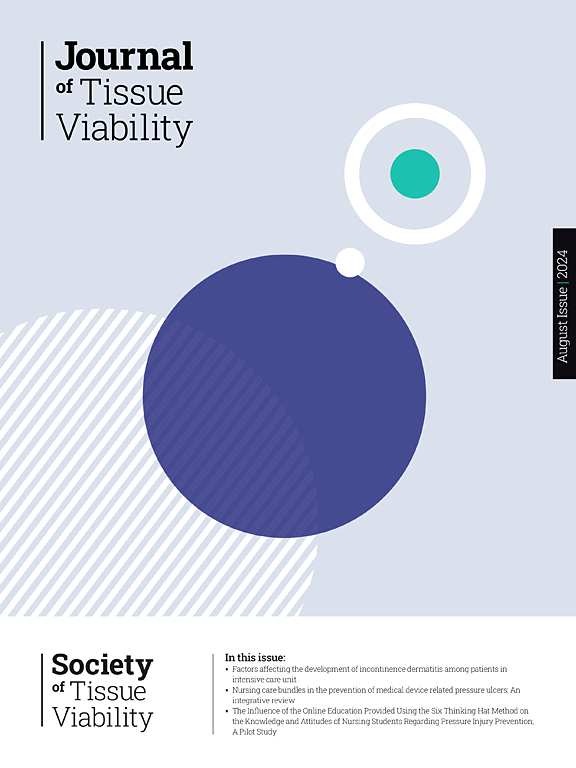Bluebelle伤口愈合问卷(WHQ)用于评估伤口愈合手术部位感染的修改和验证
IF 2.4
3区 医学
Q2 DERMATOLOGY
引用次数: 0
摘要
背景:手术伤口继发性愈合是常见的。手术部位感染(SSI)常使愈合复杂化。SSI评估对指导治疗很重要,但现有的方法通常需要亲自评估,使其资源密集。经过验证的患者报告的SSI结果测量可能有助于克服这一局限性。目的对蓝美人伤口愈合问卷(WHQ)进行修改和验证。方法对原创面创面愈合的18项蓝美人健康量表进行改进,使其适用于二次创面愈合。测试作为评估负压伤口敷料与标准护理的SWHSI-2随机试验的一部分进行。参加者在五个时间点完成WHQ;当面(基线、康复后)和邮寄(3、6、12个月)。研究护士在伤口愈合时进行参考SSI评估。可接受性和标准效度(Bluebelle WHQ区分SSI/no SSI的能力)通过检查问卷回收率、缺失数据水平和总分灵敏度/特异性值(受试者工作特征曲线(ROC))来探讨。结果基线问卷回复率最高(672/686;98%),而邮递回复率分别为428/615(68.5%)、274/416(65.9%)及186/296(62.8%)。总体而言,观察到低水平的项目缺失数据,完成问卷报告的问题很少。区分SSI/no SSI的能力较好(ROC下面积= 0.796)。结论改良的蓝百花血清率是一种有价值的伤口二次愈合出院后评估工具。建议在研究和临床实践中使用。本文章由计算机程序翻译,如有差异,请以英文原文为准。
Modification and validation of the Bluebelle Wound Healing Questionnaire (WHQ) for assessing surgical site infection in wounds healing by secondary intention
Background
Surgical wounds healing by secondary intention are common. Healing is often complicated by surgical site infection (SSI). SSI assessment is important to guide treatment but existing methods generally require in-person assessment, making them resource intensive. A validated patient-reported SSI outcome measure may be useful to overcome this limitation.
Aim
To modify and validate the Bluebelle Wound Healing Questionnaire (WHQ) for wounds healing by secondary intention.
Methods
The 18-item Bluebelle WHQ developed for wounds healing by primary intention was modified to make it applicable to secondary healing wounds. Testing was performed as part of the SWHSI-2 randomised trial assessing negative pressure wound dressings versus standard care. Participants completed the WHQ at five timepoints; in-person (baseline, post-healing) and by post (3, 6, 12 months). A reference SSI assessment was performed by a research nurse at the time of wound healing. Acceptability and criterion validity (ability of the Bluebelle WHQ to discriminate between SSI/no SSI) were explored by examining questionnaire return rates, levels of missing data and total score sensitivity/specificity values (receiver operating characteristic curve (ROC)).
Results
Baseline in-person questionnaire return rates were highest (672/686; 98 %), with postal return rates of 428/615 (68.5 %), 274/416 (65.9 %) and 186/296 (62.8 %) at follow up points. Overall, low levels of item-missing data were observed with few problems completing the questionnaire reported. Ability to discriminate between SSI/no SSI was good (Area under ROC = 0.796).
Conclusion
The modified Bluebelle WHQ is a valuable tool for post-discharge assessment of wounds healing by secondary intention. It is recommended for use in research and clinical practice.
求助全文
通过发布文献求助,成功后即可免费获取论文全文。
去求助
来源期刊

Journal of tissue viability
DERMATOLOGY-NURSING
CiteScore
3.80
自引率
16.00%
发文量
110
审稿时长
>12 weeks
期刊介绍:
The Journal of Tissue Viability is the official publication of the Tissue Viability Society and is a quarterly journal concerned with all aspects of the occurrence and treatment of wounds, ulcers and pressure sores including patient care, pain, nutrition, wound healing, research, prevention, mobility, social problems and management.
The Journal particularly encourages papers covering skin and skin wounds but will consider articles that discuss injury in any tissue. Articles that stress the multi-professional nature of tissue viability are especially welcome. We seek to encourage new authors as well as well-established contributors to the field - one aim of the journal is to enable all participants in tissue viability to share information with colleagues.
 求助内容:
求助内容: 应助结果提醒方式:
应助结果提醒方式:


